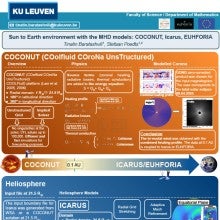Space Weather modelling tools from Sun to Earth
Tinatin
Baratashvili
KU Leuven
Stefaan Poedts, KU Leuven(1), University of Maria Curie-Skłodowska(2)
Oral and Poster
Coronal Mass Ejections (CMEs) are the main drivers of interplanetary shocks and space weather disturbances. One of the key parameters that determine the geo-effectiveness of the CME is its internal magnetic configuration. Strong CMEs directed towards Earth can have a severe impact on our planet and their prediction can mitigate possible damages. Thus efficient space weather prediction tools are necessary, in order to produce timely forecasts for the CME arrival at Earth and their strength upon arrival.
Various space weather modelling tools have been developed and utilized at KU Leuven and Royal Observatory of Belgium. The MHD models reconstruct the whole domain from the Sun to Earth. The solar corona is modelled with a 3D global MHD model called COCONUT (Perri et al. 2022). The domain is extended from the solar surface to 0.1 AU where the model is coupled to the heliospheric models EUHFORIA and Icarus. The implemented source terms, such as radiative losses, thermal conduction, approximated coronal heating allow bi-modal solar wind configuration at the outer boundary, making the model suitable for space weather purposes.
EUHFORIA (Pomoel & Poedts, 2018) is a 3D MHD heliospheric model which covers the domain from 0.1 AU to 2 AU. Different CME models, both magnetized and non-magnetized can be injected from the inner heliospheric domain. Sampling of the satellites and planets in the domain allows validation of the code by comparing the modelled data to the in-situ measurements.
The novel heliospheric model Icarus (Verbeke et al. 2022, Baratashvili et al. 2022), which is implemented within the framework of MPI-AMRVAC (Xia et al. 2018) introduces new capabilities to model the heliospheric solar wind and real CME events. Ideal MHD equations are solved in the co-rotating reference frame with the Sun. Different CME models are injected in the domain on top of the stationary solar wind. To optimize the simulations advanced techniques, such as adaptive mesh refinement and gradual radial grid stretching are implemented. The biggest advantage of the AMR in MPI-AMRVAC is that you can design the refinement in the simulations according to the purpose of the run. These techniques result in optimised computer memory usage and a significant speed-up, which is crucial for forecasting purposes.
White light images and in-situ measurements are actively used for validating the developed models, therefore the new data from PUNCH mission can be used to validate both the modelled solar corona and inner part of the heliosphere.
Various space weather modelling tools have been developed and utilized at KU Leuven and Royal Observatory of Belgium. The MHD models reconstruct the whole domain from the Sun to Earth. The solar corona is modelled with a 3D global MHD model called COCONUT (Perri et al. 2022). The domain is extended from the solar surface to 0.1 AU where the model is coupled to the heliospheric models EUHFORIA and Icarus. The implemented source terms, such as radiative losses, thermal conduction, approximated coronal heating allow bi-modal solar wind configuration at the outer boundary, making the model suitable for space weather purposes.
EUHFORIA (Pomoel & Poedts, 2018) is a 3D MHD heliospheric model which covers the domain from 0.1 AU to 2 AU. Different CME models, both magnetized and non-magnetized can be injected from the inner heliospheric domain. Sampling of the satellites and planets in the domain allows validation of the code by comparing the modelled data to the in-situ measurements.
The novel heliospheric model Icarus (Verbeke et al. 2022, Baratashvili et al. 2022), which is implemented within the framework of MPI-AMRVAC (Xia et al. 2018) introduces new capabilities to model the heliospheric solar wind and real CME events. Ideal MHD equations are solved in the co-rotating reference frame with the Sun. Different CME models are injected in the domain on top of the stationary solar wind. To optimize the simulations advanced techniques, such as adaptive mesh refinement and gradual radial grid stretching are implemented. The biggest advantage of the AMR in MPI-AMRVAC is that you can design the refinement in the simulations according to the purpose of the run. These techniques result in optimised computer memory usage and a significant speed-up, which is crucial for forecasting purposes.
White light images and in-situ measurements are actively used for validating the developed models, therefore the new data from PUNCH mission can be used to validate both the modelled solar corona and inner part of the heliosphere.

Poster PDF
Presentation file
YouTube link
Meeting homepage